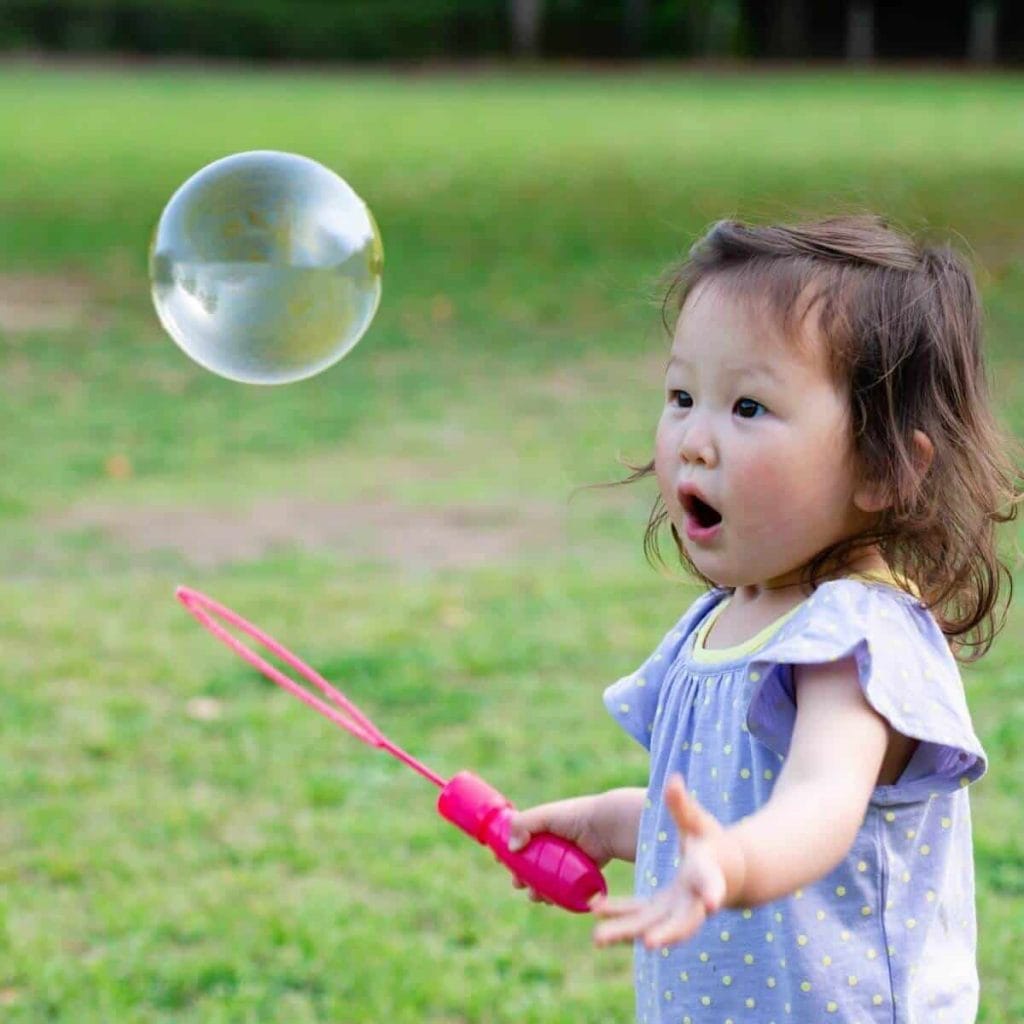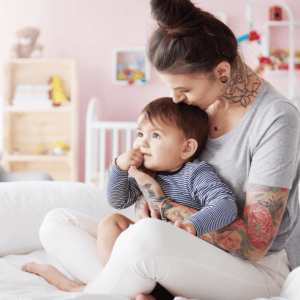Once you’ve had the pleasure of witnessing your normally well-behaved child completely lose it in the middle of a public space, you truly understand the power of toddler emotions.
They go big, and we go home.
While embarrassing, tantrums are now recognized as a developmentally appropriate reaction to a toddler’s inability to regulate their emotions.
But how do you actually improve emotional development in toddlers so they can handle those big feelings?
In this article, we’re going to take a deep dive into what the latest research tells us about emotional development and mental health in toddlers.
Emotional Health is A Tough Subject If You’ve Experienced Past Trauma
While emotional development and childhood emotional experiences may be easy to discuss for some parents, I recognize that all mothers have walked a different path.
Past injuries to your emotional development, or your child’s, make it difficult to read research about what you “should” do in order to have the best outcomes for your kids. There’s a lot of pressure to be the perfect mom.
I want you to know that children experiencing trauma, violence, or neglect in any environment are not doomed to be violent or neglectful themselves.
Even children with emotionally poor childhoods can lead a normal, healthy life with early and appropriate care from mental health professionals and supportive family members.
Undefining Motherhood shares research to be informative but never to stand in judgement of where you and your child are in your journey together.

This site contains affiliate links, meaning that we earn a small commission for purchases made through our site. We only recommend products we personally use, love, or have thoroughly vetted.
Nature vs Nurture: Is Emotional Development in Toddlers a Matter of Genes or Parenting?
A toddler’s emotional state is significantly more complex and harder to define in comparison to infancy.
The emotional landscape established by a child’s caregivers in infancy sets the stage for the rapid formation of neural connections related to emotional regulation in toddlerhood.
Emotional regulation is another way to say “self-control” or “the ability to handle strong emotions.”
When examining a child’s temperament, which includes emotional regulation, it’s hard not to revisit the question of nature vs nature.
Why is my son so introspective? What makes my nephew so analytical? Why does my friend’s little girl seem full of spitfire?
In some ways, these kids are smaller versions of their parents, but…in other ways…they are unique.
The more you understand about how our brains develop, the more you find “Nature vs Nurture” is a false dichotomy. Like most things in parenting, it’s just not that simple.

The Path to Emotional Development in Toddlers Is Written in Their Genes
Without getting into the weeds, the genes inherited by a child from their parents are not the same in adulthood.
Our genes can be manipulated by our environment, and, depending on the manipulation, genes may not function as well once they are changed.
I went to school for environmental science, and we often discussed how toxic chemicals altered genes, but chronic stress and even diet can be harmful to your genes. This type of science is epigenetics.
We look to epigenetics to understand how a toddler’s environment (their home and community at large) impacts their development.
Critical organs including the brain are still forming at this age, so children are much more vulnerable to environmental factors affecting genes.
How Your Toddler’s Environment Impacts Their Emotional Well-Being
Positive childhood experiences in supportive environments can actually activate parts of a child’s genome that promote successful navigation of emotional experiences throughout life.
Conversely, negative experiences can de-activate these genes and reduce a child’s capacity to cope with difficult emotions or traumas.
Scientists believe this adaptation exists to help children survive by developing appropriate physiological responses to their unique environment.
A tough environment requires a tough kid who needs to focus more of their energy on basic survival, whereas a plentiful environment provides more opportunities for strong social and emotional connection.
A toddler’s brain is incredibly vulnerable to environmental stress at a time when their brains are laying out the pathways they need for a healthy, emotionally fulfilling life.
You may not be able to control every environmental assault on your child’s genome, but there are numerous ways you can help activate those positive gene functions in everyday life.
In the next section we’ll discuss how you can take advantage of this vulnerable time in your child’s life to fill it with positive social and emotional experiences.
Parenting Can Impact Emotional Development in Toddlers
What does it mean to have “good” emotional development in toddlers? And what characteristics result in emotional regulation into adulthood?
The skills that facilitate emotional regulation are known as “executive functions.” They are also a good indicator of our overall cognitive health.
Executive functions include:
- Memory
- Flexibility
- Self-Control
How Can Parents Improve Brain Architecture?
The foundation for these skills are laid in a child’s brain architecture (or, how their brain is wired). A child’s brain architecture is built primarily through a parent’s back and forth interactions with them. This can include making eye contact, exchanging facial expressions, and sharing sounds and words.
Scientists found that being responsive and interactive with your toddler in this way improves the areas of the brain responsible for emotional regulation and many other biological factors that result in optimum brain development.
Making regular conversations with children part of our routine has the added bonus of also teaching kids empathy and helping them understand their role in the family.
Your child can also learn executive functioning skills slowly over time by participating in daily living, as well as playtime where you model strong executive function.
This means you may need to work through your own mental health struggles, too.
Working Through Your Past for Your Child’s Future
If you’re dealing with past childhood traumas or have even just discovered you have them, get help from a mental healthcare professional right away. Parenting has a way of opening up old wounds and keeping them open until they’re addressed.
Be honest with your child and with any co-parents that you don’t always have all the answers.
I can’t tell you how many times I have told my son, “Mommy is having a really hard time being calm and happy. She feels sad and sometimes when she feels sad, she says things that are mean and make Elim feel sad too. I’m sorry, buddy. “
You may not always act like the perfect parent and that’s okay. Be up front about that and admit when you acted in a way that you did not like. Your vulnerability will demonstrate to your child how sincere you are in your efforts to connect with them.
Honestly, what is a greater gift to your child than letting them see that you can be imperfect and still worthy of growth and love?
Practical Ways to Influence Emotional Development in Toddlers
According to the Center on the Developing Child at Harvard University, there are four types of everyday experiences that help build executive function in children 18 months to 3 years. These include:
1. Physical Activity
Toddlers are physical powerhouses. Not only that, they are uniquely resilient when it comes to trying out new things.
Toddlers try the same movement over and over for days on end until they figure it out. They get frustrated but they don’t doubt themselves or give up when things get hard.
You can use this natural resilience to your advantage in introducing your child to many new physical challenges. These physical activities help children develop motor control and the executive function of memory. They also offer practice at maintaining focus for longer periods of time.
Remember, your child needs good executive function skills like memory, flexibility, and self-control to have strong emotional regulation.
Give these fun and engaging physical activities a try!
- Invite them to participate in your favorite game or sport while teaching them the rules and boundaries of the game.
- Sing songs that include hand or body movements like “If You’re Happy and You Know It” or “Head, Shoulders, Knees, and Toes“. Vary the speed of movements from fast to slow.
- Offer plenty of opportunities for physical exercise, preferably outdoors. For instance, my son and I often sneak onto our neighborhood tennis courts when they’re not in use. There, my toddler can run full speed for almost an hour chasing used tennis balls.
For examples of toys that promote physical play, check out our article on Montessori toys for 1 year old toddlers.

2. Conversations and Stories
A toddler that can identify, name, and communicate their emotions effectively to their caregivers is a happy toddler.
Unfortunately, I am not sure that this unicorn-like toddler exists. The more realistic toddler encounters inexplicable emotions that overwhelm or confuse them, which leads to major tears and tantrums.
Tantrums are a developmentally appropriate reaction to big feelings, and like adults, sometimes a good cry is just what’s needed to feel better.
The good news is that we can work with our toddler using conversations, reading, and storytelling to help describe the inner workings of their brains and how their reactions impact those around them.
Try these word-building activities with your toddler!
- Sportscast their play by describing what they are doing. If they seem excited about something, recognize it and describe it. “Wow, you stacked all six blocks together. You seem really happy and excited about that!”
- Reflect on past shared events, especially ones that caused big emotions. For example, my son and I recap the time he was carrying his bicycle helmet and skinned his knee so badly it started to bleed. He can only say “ouchie bicycle,” but that’s enough for me to understand what he wants to talk about. I describe what happened including how sad it made him feel. Sometimes we’ll pretend to cry or pretend to apply a bandage. I love this sort of play as it prepares him mentally and emotionally for future ouchies and boo boos.
3. Classic Matching and Sorting Games
Matching and sorting games are wonderful for developing the executive function of working memory, but it also helps toddlers work on focus and attention span.
Let your toddler try their hand at these fun matching and sorting games.
- Create a matching game using items around your home. I suggest starting with matching colors before moving to matching shapes and sizes. Add random child-safe yellow and blue objects to a large basket and encourage your child to sort the items by color into two smaller baskets. Include a third or fourth color as your child’s skill at matching grows.
- Offer your older toddler a simple puzzle starting with two or three pieces and moving to smaller pieces over time.
4. Imaginative Free Play
There is a lot of noise in the parenting sphere around “planned” activities for toddlers. Perhaps due to the competitive nature of our society, there is pressure to introduce scheduled activities and academic work at an early age.
Let’s lead a revolt by example against this idea!
These practices conflict with the sorts of experiences that are known to promote strong mental health in young children. It’s time to give our children the space for quiet, imaginative free play.
“The monotony and solitude of a quiet life stimulates the creative mind.” – Albert Einstein
Here are just a few of the many ways you can encourage imaginative free play.
- Offer everyday household objects as play items. Leave child-safe pots, pans, and utensils around for your child to practice “cooking.” Set out a basket with some items of clean laundry and let them “do laundry.” Let them decide how to play and only get involved if they invite you.
- Offer unfamiliar household objects as play items too. Empty pump bottles, colanders, old calculators, or tea tins are ripe with possibilities if your child has never seen them used before. Just imagine how intrigued you would be if someone handed you an unusual object and said, “What do you think this is for?”
Promoting Strong Emotional Development in Your Toddler
We’ve covered a lot of ground in this article–from the frontiers of genetic research to the hidden functions of our brain to a busy child’s playroom.
I think that says a lot about the enormous challenge parents face when trying to shape their toddlers’ emotional lives. Promoting strong emotional development in toddlers requires real thought and practice!
Did any of the research on emotional development in toddlers shock or surprise you? How do you help your toddler cope with strong emotions?









